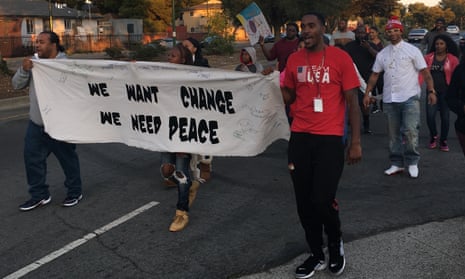The banner was draped over a sports car parked at an Oakland street corner. “We want change,” it read. “We need peace.”
It was early on Friday evening at 84th and Bancroft, the corner where a young father, Twon Shavers, had been shot dead just a few weeks before. Joseph Church Truehill had markers and was encouraging people to sign the banner with the names of those they had lost to gun violence. It was the first peace march the 30-year-old had organized.
“Stuff like this used to be corny to me,” he said. “I used to be on the other side of the road. I was one of the people helping with the violence and egging on the negativity.”
Truehill and his friends were gathered in East Oakland, the center of the city’s gun violence epidemic. The blocks around them have seen shooting after shooting, including people injured or killed as they mourned previous victims. Truehill and fellow organizer Lauren Richardson sent round a flier, advertising their march as “a cry for an end to the senseless violence”.
Earlier this summer, Rudy Giuliani criticized black Americans for protesting shootings by police officers rather than shootings of young black men by other young black men. The former New York City mayor suggested, inaccurately, that the Black Lives Matter movement never held protests about community gun violence in Chicago.
“What we’ve got to hear from the black community,” Giuliani said, “is how and what they are doing among themselves about the crime problem in the black community.”
But black Americans in neighborhoods that see constant gun violence do try to make their voices heard, in protests like the one Truehill helped organize: community led, often small and largely ignored by news organizations.
Thirty people showed up on Friday, most of them black men and women in their mid-20s. Gun violence was deeply personal to them. One 24-year-old, Chris Head, said he had lost 30 friends. He was “blessed”, he said, that it was only that many.
“At least I can count,” he said. “Some people can’t count.”
The march and vigil lasted two hours, buoyed by waves and cheers from people along the route and honks of support from cars. No television crews or reporters from local news organizations showed up. The single reporter present had only learned about the protest by chance, from one of Truehill’s mentors, a local pastor.
Truehill has lost two brothers to violence in Oakland. But for him, he said, a turning point had come just a few weeks before, when 17-year-old Regina Jeffries was shot dead at a vigil for two teenagers who drowned in a reservoir earlier this summer. She was one of more than 39 people killed and 175 shot in Oakland this year, through the end of July.
“After that, I figured that something needed to change,” Truehill said. “If you get the young black people in the community together, you can do a lot.”
He was inspired by a 7 July march in Oakland against police brutality that temporarily shut down Interstate 880. Thousands joined the protest; for the first time, Truehill was among them.
“I don’t really do stuff like this,” he said. “I mean, pretty much everybody know that. This is me trying to set an example for people who know me.”
Nate Millheim, a pastor who runs the Oakland Leadership Center, a storefront mentoring organization for Oakland youth, told the group: “I’ve been at a lot of peace marches in Oakland, in the eight years I’ve been here, but they’re pretty much usually only older or mostly older people. I think when younger people come out and lead and, like, bring their friends, there’s something special about that.
“I know we ain’t that deep as we want to be, but it don’t matter how deep we are; we come together, we bigger,” Truehill said.
Richardson, the co-organizer, said: “Everybody is representing different things, – some people have lost family members to violence, some people are representing being against police brutality.”
Another marcher said: “It’s good to have the little kids. They see the younger generation trying to stop the violence.”
